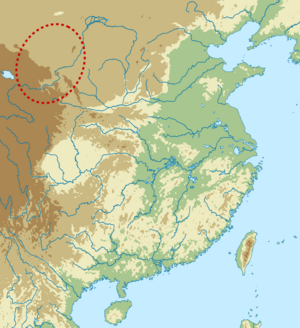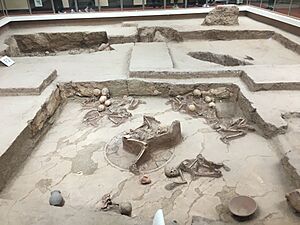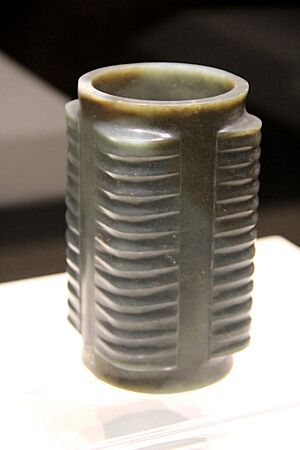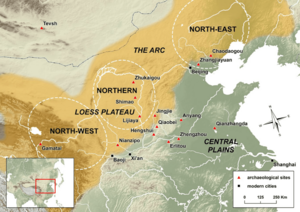Qijia culture facts for kids
 |
|||||||
| Geographical range | upper Yellow River | ||||||
|---|---|---|---|---|---|---|---|
| Period | early Bronze Age | ||||||
| Dates | c. 2200 – c. 1600 BC | ||||||
| Preceded by | Majiayao culture | ||||||
| Followed by | Siwa culture Siba culture Xindian culture Shanma culture |
||||||
| Chinese name | |||||||
| Traditional Chinese | 齊家文化 | ||||||
| Simplified Chinese | 齐家文化 | ||||||
|
|||||||
The Qijia culture (pronounced Chee-jee-ah) was an ancient group of people who lived in China a very long time ago. They existed during the early Bronze Age, from about 2200 BC to 1600 BC. This means they lived over 4,000 years ago!
These people lived in the upper Yellow River region. This area is now part of Gansu and eastern Qinghai provinces in China. The Qijia culture is known for being one of the first groups in China to use bronze.
The culture gets its name from a place called Qijiaping Site in Gansu Province. Before the Qijia people, another group called the Majiayao culture lived in the same area. They also knew how to work with metals. The Qijia culture took over from the Majiayao culture around 3000 BC.
The Qijia people lived in a time when the climate was warm and wet. This was great for farming and helped their population grow. Later, the weather became drier. This made life harder for the Qijia culture.
Contents
Discovering the Qijia Culture
Archaeologists study the Qijia culture to learn about ancient metalworking. They want to know where the idea of using bronze came from. This knowledge helped the Qijia and other cultures in Gansu.
The Qijia culture made some of the first bronze and copper mirrors found in China. They also kept many horses. This shows they were good at domesticating animals.
Important places where Qijia culture artifacts have been found include Lajia, Huangniangniangtai, Qinweijia, and Dahezhuang. Sites were also found in Ningxia and Inner Mongolia.
Over 350 Qijia culture sites have been discovered. Many metal objects, mostly made of copper, have been found. Some bronze items were also excavated. These finds happened in Gansu and Qinghai provinces.
Scientists have studied 25 metal pieces. Most were copper. The rest were copper mixed with other metals, like tin. It's thought that the idea of using bronze might have come from other cultures. These include the Afanasievo culture and the Seima-Turbino phenomenon from Central Asia and Siberia. They likely shared their metal skills with the Qijia culture.
Many items from the Qijia culture seem to have come from the Seima-Turbino culture. This culture was located in the Altai Mountains area.
Pottery Styles
The Qijia people made pottery in different ways. They created fine red pottery and rough reddish-brown pottery. Some gray pottery was also found. All their pottery was made by hand. They did not use a pottery wheel.
Qijia pottery has its own special look. But it also shares features with the Longshan culture from Shaanxi. Some ideas from the Majiayao culture can also be seen in their pottery.
Machang Culture Connections

The Machang culture also lived along the Yellow River from 2500 BC to 2000 BC. It grew out of the Banshan culture. The Machang culture existed at the same time as the Qijia culture. Even though they were different, they traded ideas and goods. Some experts think the Machang culture was part of the larger Majiayao culture. They also believe the Qijia culture came from the Machang.
Mogou Site Discoveries

A large Qijia culture cemetery was found at Mogou in Lintan County, Gansu. Digging started there in 2008. Over a thousand graves have been uncovered. People lived in this area during the first half of the second millennium BC.
Thousands of items have been found in the graves. These include pottery, bone ornaments, shells, and metal objects. This site has the most copper and bronze items from the Qijia culture. More than 300 metal pieces were found. Most are tools like knives or ornaments like buttons and earrings. Some new types of items, like neck rings and armbands, were also found.
Tests show that tin bronze was the main metal used at Mogou. Other metal mixes, like copper with tin and lead, were also used. Some items were made by melting metal and shaping it while hot.
Two small pieces of iron were also found at the Mogou cemetery. They are from around 1400 BC. One piece was made from iron that came from the ground, not from a meteorite.
Later Qijia Culture
Towards the end of its time, the Qijia culture moved away from the west. Their population also became smaller. Some experts believe that the Siwa culture came from the Qijia culture. Also, the Kayue culture is thought to have developed from the western part of the Qijia culture.
Genetics of the Qijia People
Scientists have studied the DNA of ancient people from Qijia and Mogou sites. They found that these people are closely related to modern Sino-Tibetan-speaking people. This includes modern Qiang people and Han Chinese. They are also related to ancient farmers from the Yellow River area.
The Qijia culture people were mostly (about 80%) like the Neolithic farmers from the Yellow River. The rest (about 20%) were like hunter-gatherers from the Amur region.
Images for kids
-
Bronze mirror from Gansu. Qijia culture (2400–1900) National Museum of China
See also
- History of metallurgy in China
- Dadiwan culture
- Majiayao culture
- Yangshao culture
- Xishanping






